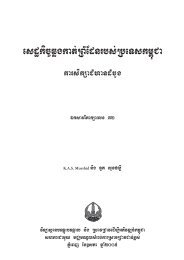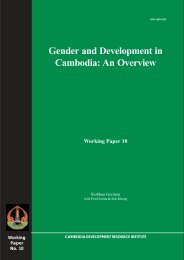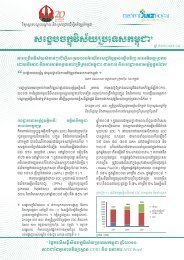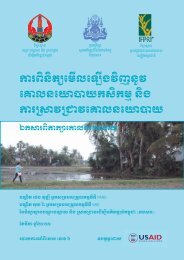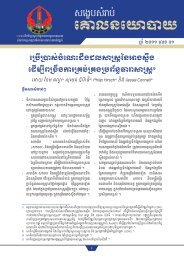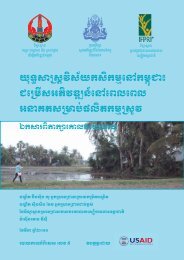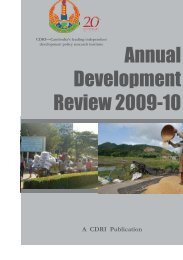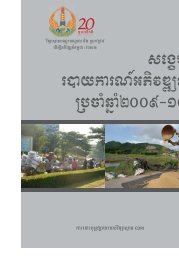Foreign Investment in Agriculture in Cambodia CDRI Working Paper ...
Foreign Investment in Agriculture in Cambodia CDRI Working Paper ...
Foreign Investment in Agriculture in Cambodia CDRI Working Paper ...
You also want an ePaper? Increase the reach of your titles
YUMPU automatically turns print PDFs into web optimized ePapers that Google loves.
Annual average growth (gross value added) <strong>in</strong> the sector was at about 5.6 percent from<br />
2002 to 2009. Such slow growth can be attributed to weak rural-urban l<strong>in</strong>kages; unsecured land<br />
ownership; sluggish <strong>in</strong>vestment, both public and private, particularly <strong>in</strong> irrigation, transport<br />
and agricultural research; and limited support <strong>in</strong>frastructure such as availability of and access<br />
to f<strong>in</strong>ance and affordable reliable energy and telecommunication services (World Bank 2004a,<br />
2004b, 2006).<br />
Crop farm<strong>in</strong>g dom<strong>in</strong>ated by paddy rice cultivation, contributes around half of the<br />
national agricultural output. Fisheries, <strong>in</strong>clud<strong>in</strong>g freshwater, aquaculture and mar<strong>in</strong>e, account<br />
for approximately 33 percent, livestock and poultry contribute about 16 percent, and forestry<br />
and logg<strong>in</strong>g around 8 percent of total agricultural output.<br />
2.2. Production and Harvested Areas<br />
Alongside the rapid growth <strong>in</strong> manufactur<strong>in</strong>g <strong>in</strong>dustry <strong>in</strong> the past decade, an expansion<br />
of paddy rice, <strong>Cambodia</strong>’s ma<strong>in</strong> staple food, has been remarkable. The area under paddy rice<br />
<strong>in</strong>creased from about 2.4 million ha <strong>in</strong> 2004 to 2.7 million ha <strong>in</strong> 2009, result<strong>in</strong>g primarily from<br />
the government’s expansion plan. Production also surged significantly from 4.2 million tonnes<br />
<strong>in</strong> 2004 to 7.6 million tonnes <strong>in</strong> 2009, thanks to meagre loss of cultivated areas, which is the<br />
difference between total cultivated and harvested areas. This substantial growth <strong>in</strong> production<br />
has led to a considerable paddy rice surplus (Figure 2). The sub-sector is estimated to employ<br />
around 2,940,000 people, which shows its significant potential to contribute to poverty<br />
alleviation <strong>in</strong> rural <strong>Cambodia</strong> (UNDP 2007: 5).<br />
There is also evidence of fast and stable growth <strong>in</strong> the production of other ma<strong>in</strong> crops such<br />
as cassava, maize and soybeans, and a slight <strong>in</strong>crease <strong>in</strong> mung beans, between 2002 and 2009<br />
(Figure 3). This growth can be attributed to ris<strong>in</strong>g prices, pushed upwards by <strong>in</strong>creas<strong>in</strong>g demand<br />
for these crops <strong>in</strong> neighbour<strong>in</strong>g Thailand and Vietnam, which are their traditional buyers. In<br />
terms of employment, soybeans, maize and cassava employ about 16,500, 12,500 and 4,000<br />
workers, respectively (UNDP 2007: 5). <strong>Cambodia</strong> also produces a wide range of specialised<br />
crops, <strong>in</strong>clud<strong>in</strong>g sweet potato, peanuts, sesame, sugarcane, tobacco, jute and vegetables.<br />
A steep acceleration <strong>in</strong> rubber prices on <strong>in</strong>ternational markets dur<strong>in</strong>g the past decade<br />
has generated considerable <strong>in</strong>terest from both domestic and foreign <strong>in</strong>vestors <strong>in</strong> the sector <strong>in</strong><br />
<strong>Cambodia</strong>, mak<strong>in</strong>g this the country’s ma<strong>in</strong> <strong>in</strong>dustrial crop. There has also been considerable<br />
engagement by Vietnamese <strong>in</strong>vestors <strong>in</strong> recent years, but the exact magnitude of <strong>in</strong>volvement is<br />
difficult to estimate. The latest data from MAFF show that the total area under rubber plantation<br />
(both mature and immature trees), <strong>in</strong>clud<strong>in</strong>g rubber estates, new <strong>in</strong>vestments <strong>in</strong> the form of<br />
ELCs and smallhold<strong>in</strong>gs, was 130,921 ha <strong>in</strong> 2009, up from 82,000 ha <strong>in</strong> 2007. Figure 4 shows a<br />
decl<strong>in</strong>e <strong>in</strong> the tapp<strong>in</strong>g (mature rubber) area, which seems to contradict the figures above: some<br />
rubber trees are too old to be tapped and therefore have to be felled. Normally, rubber trees are<br />
ready for tapp<strong>in</strong>g with<strong>in</strong> three to five years of plant<strong>in</strong>g. MAFF data (2007) <strong>in</strong>dicate that 25,275<br />
ha of old (i.e. unproductive) rubber trees were felled between 1996 and 2006.<br />
4 <strong>Foreign</strong> <strong>Investment</strong> <strong>in</strong> <strong>Agriculture</strong> <strong>in</strong> <strong>Cambodia</strong>



